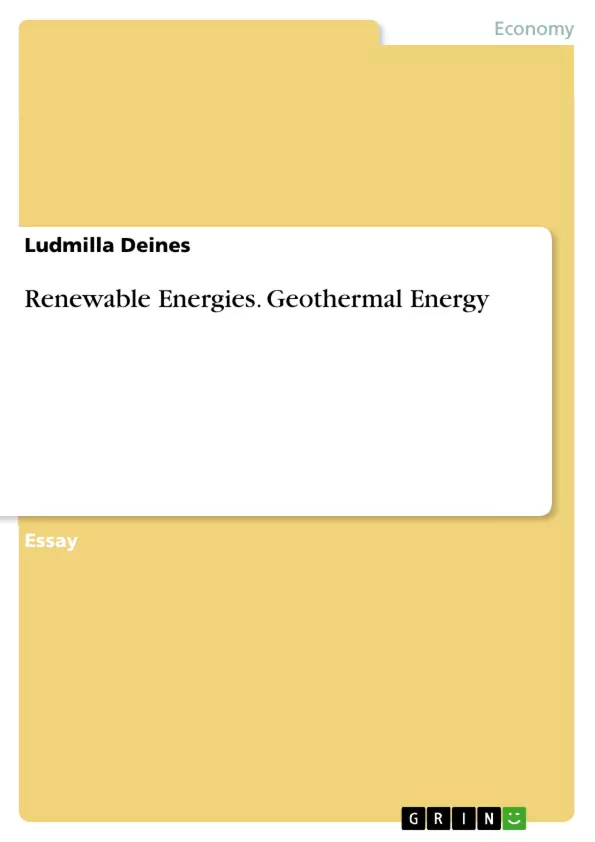Nowadays, it is unimaginable for people, at least in industrialized countries, not to have any access to energy sources. For the industry sector it is the basic precondition for its existence. For every little step within the production process, being the production of a good itself, the handling with raw materials or the transportation of the final product to the customer, plenty of energy is required. Private households also consume a lot of energy. But due to the global population growth, the available earth’s resources have come under enormous pressure to meet the humans’ energy needs (Pérez Latorre, 1999, p. 2). In the last 30 years the world’s population has grown by more than 30% (www.weltbevoelkerung.de) and reached the present status of about 6.6 billion people (www.cia.gov). The total energy consumption has even increased more quickly comparing to the number of people on the planet. At the same time the population continues to grow and is estimated to reach about 9.1 billion people by the year 2050 (www.un.org).
As the supply of oil, gas, coal and uranium, so called classic energy resources, is quite limited, the increase of population could result in the energy supply shortfall with considerable economic and social consequences. But this is not the only problem. The reserves of fossil fuels are distributed unequally over the globe (BMU, Renewable Energies – Innovations for the future, 2006, p. 11). The high dependence of energy-hungry industrial countries from energy supplying countries can even lead to political conflicts. Furthermore the use of these energy resources has significant environmental effects. The capacity of the environment to absorb the waste produced by the energy consumption is strictly limited, too. These waste products not only damage the environment, but also are harmful to the human health (BMU, Renewable Energies – Innovations for the future, 2006, p. 12).
The challenge of this essay is to analyse, whether and if so which alternative energy sources are to be considered as an answer to the problems mentioned above. Thereby I want to examine sustainable energy resources in order to find out, whether their utilization make sense politically, economically and environmentally. First I will provide general information about renewable energies and give an overview of main renewable energy sources. Finally I will focus on geothermal energy, analysing this energy source more detailed.
Inhaltsverzeichnis (Table of Contents)
- Challenge and Objectives of this Essay
- Renewable Energies
- Status and Perspectives
- Global Potential of Renewable Energies
- Solar Energy
- Biomass
- Wind Energy
- Hydropower
- Geothermal Energy
- History
- The Nature of Geothermal Resources
- Technologies
- Potential and Utilization of Geothermal Energy
- Summary and Conclusion
- Appendix - Energy Units
- Bibliography
Zielsetzung und Themenschwerpunkte (Objectives and Key Themes)
This essay aims to analyze the viability of alternative energy sources, specifically focusing on sustainable renewable energy resources. The objective is to determine whether these resources, from a political, economic, and environmental perspective, represent a suitable solution to the challenges posed by traditional energy sources like oil, gas, coal, and uranium.
- The growing global demand for energy in light of population increase and its impact on traditional energy sources.
- Environmental consequences associated with traditional energy sources, including pollution, resource depletion, and climate change.
- The potential of renewable energy sources to address these challenges and provide a sustainable energy future.
- An examination of the political, economic, and environmental feasibility of utilizing renewable energy sources.
- A focused analysis of geothermal energy, its history, resources, technologies, and potential for utilization.
Zusammenfassung der Kapitel (Chapter Summaries)
The first chapter explores the pressing issue of energy demand in the context of global population growth and limited fossil fuel resources. It highlights the significant environmental impact of traditional energy sources, including pollution, resource depletion, and climate change. This chapter sets the stage for exploring alternative energy solutions, particularly renewable energy sources.
The second chapter introduces the concept of renewable energy, outlining its status and perspectives in the broader energy landscape. It delves into the global potential of various renewable energy sources, including solar, biomass, wind, and hydropower. This chapter provides a broad overview of the different renewable energy options available.
The third chapter focuses specifically on geothermal energy, delving into its historical development, the nature of geothermal resources, and various technologies used for its extraction and utilization. It also examines the potential of geothermal energy as a sustainable energy source, discussing its advantages and limitations.
Schlüsselwörter (Keywords)
This essay revolves around the themes of renewable energy, sustainable energy sources, geothermal energy, environmental impact, energy demand, population growth, resource depletion, climate change, political feasibility, economic feasibility, and environmental feasibility.
- Arbeit zitieren
- Ludmilla Deines (Autor:in), 2008, Renewable Energies. Geothermal Energy, München, GRIN Verlag, https://www.grin.com/document/90338



